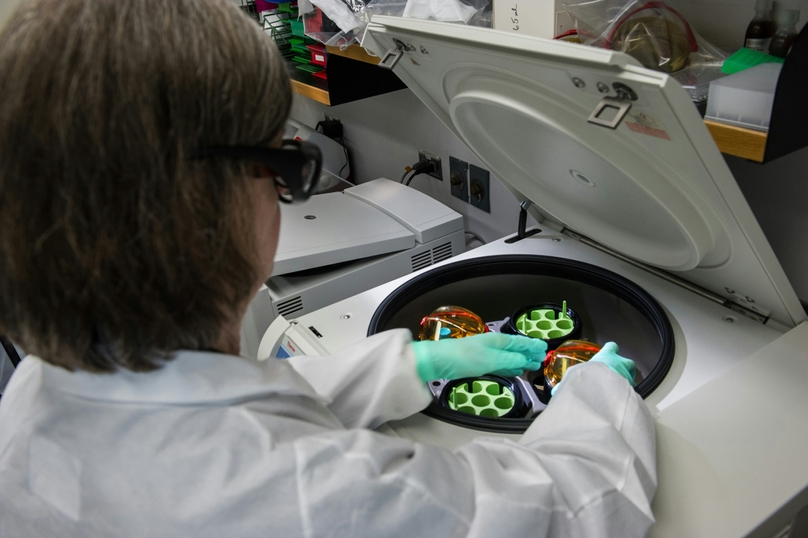Every lab’s aspiration is an effortless workflow where LIMS requirements are met with precision. Such a dream encompasses software that does not falter, inventory that doesn't diminish unnoticed, and a team in full control of every process. Creating a lab with such perfect rhythm begins not with the biggest budget or the most cutting-edge technology but with well-defined LIMS requirements.
At Genemod, we are your resource for optimizing lab automation system and software usage. We comprehend the gravity of these tools in research labs and create tailored solutions that put your team at ease. The tedium of manual input is replaced by effortless automation, allowing researchers to focus on groundbreaking scientific work.
Genemod further propels the quest to develop the best lab inventory management software. Our solution focuses on usability and efficiency, presenting a clear and reliable system that syncs your lab's demands. We ensure that you not only know what's in your inventory, but also understand its direct impact on your research.
Involve All Key Stakeholders in LIMS Requirements Gathering
One critical mistake labs make is not involving all key stakeholders in the LIMS requirements gathering process. This includes lab technicians, IT staff, quality managers, and any other personnel who interact with your current system daily. Their firsthand experience can provide invaluable insights into what features are necessary, which are nice to have, and which are irrelevant for your lab's operations.
By incorporating feedback from a diverse group of users, you can ensure that the LIMS requirements you compile will address the actual needs of your lab, making the implementation more likely to succeed. This collaborative approach helps build a sense of ownership among stakeholders, ensuring better adoption and utilization of the new system.
Conduct Comprehensive Process Mapping for Workflow Integration
Conducting a comprehensive process mapping is necessary to ensure that your new LIMS can be seamlessly integrated into your lab's existing workflows. This involves documenting your lab's processes, from sample intake to data analysis and reporting. The goal is to identify any steps that could be streamlined or automated with the right LIMS features and any unique processes that require special considerations.
This detailed map serves as a guide for customizing the LIMS to fit your lab's specific needs. It helps prevent the oversight of critical steps and ensures that the system supports, rather than disrupts, your lab's current workflow. Effective process mapping can dramatically enhance the efficiency and accuracy of your lab's operations once the LIMS is in place.
Study Current Bottlenecks to Enhance LIMS System Design
Every lab has its bottlenecks - those areas where processes slow down, causing delays and inefficiencies. Identifying these bottlenecks is crucial for designing a LIMS that addresses these issues head-on. Analyze your current operations, pinpoint where delays occur, and understand their reasons. This investigation will guide you in selecting or customizing a LIMS with features to eliminate these bottlenecks.
Whether automating data entry, streamlining sample tracking, or facilitating faster report generation, the right LIMS can transform your lab's workflow. By focusing on alleviating current pain points, you ensure the LIMS implementation will bring about meaningful improvements to your lab's productivity and efficiency rather than just being a new tool to learn.
Define Specific Data Management and Analysis Needs
Before choosing a LIMS, defining your lab's specific data management and analysis needs is vital. Rather than relying on generic features, aim for a system to handle your exact data type and volume.
For biopharmaceutical researchers dealing with genomics data, consider a LIMS that can handle multiple data formats - from raw sequencing files to variant data. Similarly, for labs handling a high throughput of samples, a system that tracks and traces sample data in real-time and provides automated alerts on status changes may be demanded.
Evaluate Compliance and Regulatory Requirements
Compliance with pertinent regulations is a key consideration when choosing a LIMS. Regulatory bodies impose precise rules on lab data management, with heavy penalties for non-compliance. Therefore, your LIMS should support your ability to meet these guidelines.
Each industry and country can have different regulatory requirements. For instance, labs involved in drug development need to comply with FDA regulations. Compliance can extend into many areas, from maintaining records and audits to ensuring data integrity and traceability. Some LIMS have built-in features designed to assist with certain compliance aspects, such as electronic signatures and access controls.
Assess Future Scalability and Expansion Goals
One of the main advantages of a LIMS is its ability to scale as your lab grows. Having a system that fits your needs perfectly today but cannot handle your lab's growth tomorrow can lead to major problems. Therefore, assessing future scalability and expansion goals is important when defining your LIMS requirements.
Consider your lab's growth trajectory and how your data management needs might change. This could involve increasing the number of samples processed, adding new types of tests, or expanding into new research areas. Your LIMS should be able to accommodate this evolution without major overhauls or disruptions to your workflows.
A New Era for Your Lab
Genemod is not here to just sell a product—we’re here to pioneer change. Contact us today to learn how Genemod can enable a smarter, faster, and more organized laboratory experience for you.












